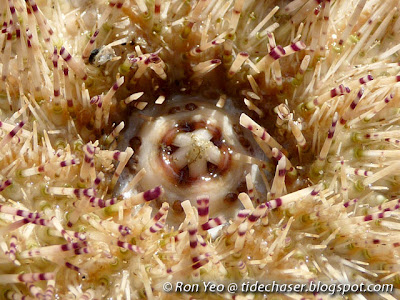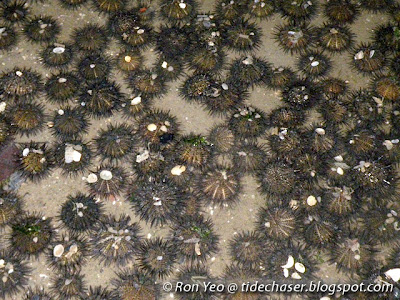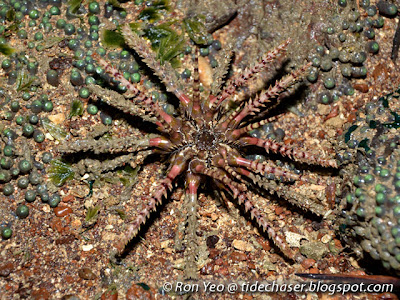Sea urchins (class Echinoidea) are animals with a round, rigid skeleton (test) made of interlocking calcite plates. The test is hollow inside, containing its various organs, and covered with lots of spines on the outside. They belong to a bigger group of animals called the spiny-skinned animals (phylum Echinodermata - "echino" roughly means "spiny"; "derma" roughly means "skin"). Examples of other echinoderms include sea stars, sea cucumbers, and feather stars.

The spines can come in various forms - long or short, smooth or rough, sharp or blunt. They not only help the sea urchin to move, but deter predators as well. Some sea urchins are venomous, and hence it's a good habit not to pick up any of them. The venom may be delivered by the spines or tiny stalk-like structures with biting jaws called "pedicellariae".
Like other echinoderms, sea urchins generally have a five-part body plan with radial symmetry (i.e. pentaradial symmetry), at least in some stage of life. In other words, you can divide a sea urchin into 5 equal parts. Also, they are able to regenerate lost body parts - such as spines lost to predators. Echinoderms are brainless, but despite that, they can still perform their daily functions - they can move, they can eat, they can shit, and they can reproduce - all these without a brain! Also, instead of blood vessels, echinoderms have a water vascular system. This system is essentially a network of water-filled vessels used for internal transportation of oxygen, food and waste.

The mouth of a sea urchin is on its underside, comprising five elongated vertical jaws held together in a structure known as the Aristotle’s lantern. Sea urchins generally feed on algae and seagrasses, though some may scavenge. The anus is on the top side. They have separate sexes, and usually reproduce by broadcasting their eggs and sperms into the water.
There are two main groups of sea urchins: the regular sea urchins with spherical tests; and irregular sea urchins with more flattened tests that are bilaterally symmetrical. The latter generally lacks the Aristotle’s lantern as well. Interestingly, the regular sea urchins are usually found in seagrass meadows and coral reefs, while the irregular sea urchins are typically burrowers in sandy substrates. In Singapore, more than 20 species of sea urchins have been recorded.
Here are the sea urchins found in Singapore that I managed to photograph.
Order Diadematoida
Members of this order are regular sea urchins with hollow spines, many of which contains venom. Many have long spines.

The Long-spined Sea Urchin (Diadema setosum) is a regular sea urchin commonly seen on our reefs. It has long, needle-like spines which break easily upon contact. These spines are hollow, containing a mild venom, and broken spines are very difficult to remove when they penetrate the victim's skin of the victim, causing pain and discomfort. This sea urchin has an orange anal cone and five equally spaced white spots on the upper side. The test can be up to 8cm wide.
Order Camarodonta
Members of this order are regular sea urchins, mostly with shorter spines. Their lanterns come with keeled teeth, and they usually have enlarged plates.

The Black Sea Urchin (Temnopleurus toreumaticus) is seasonally abundant on Singapore's northern shores, and at times hundreds, if not thousands, can be found along a shore among seagrasses.

In Latin, "toreuma" means "carved or embossed work", possibly refering to the numerous intricately arranged bumps (where the spines and tube feet extend from) on the small test (up to 4cm wide).

The White Sea Urchin (Salmacis sp.), also seasonally abundant, usually occurs in seagrass meadows. They are often found camouflaged with dead shells, rock fragments, seaweed or seagrass. While it can occur in similar habitats as the previous sea urchin, it is usually much larger, with the test reaching almost 10cm wide.

While they are mostly whitish in colour, individuals with brown, purple or pink spines have been seen too. In the water, translucent tube feet can be seen extending out, which sticks to surface and hence help the sea urchin to move around and camouflage.
Order Cidaroida
Members of this order have thick, blunt spines on their tests. They somewhat resemble pencil-holders with "pencils" poking out, and hence the common name pencil sea urchins.

The Thorny Pencil Sea Urchins (Prionocidaris spp.) are seasonally abundant. Their thick spines often come with darker bands. Bits and pieces of seaweed and seagrass are often found entangled among the spines.

Two species have been seen in Singapore: one with thicker and shorter spines, and another with thinner, longer and sharper spines. One of the species also has purple or pinkish spots at the base of the main spines. The two sea urchins above should be Prionocidaris bispinosa, since they lack the spots. Some of the bigger specimens may have tests reaching width of more than 8cm.
Order Spatangoida
The sea urchins from this order are usually called heart urchins. They are irregular sea urchins with oval or heart-shaped tests. Unlike other sea urchins, they have a definite front and rear end. They often burrows in the sand and hence, they are not often spotted - there could be many of them under the sand that you are standing on! They feed on tiny organic particles (detritus).

Occasionally, they can be seen on the sand surface or on pebbles near sand, moving around with their short spines on the underside. Three species have been recorded from Singapore.

The Elongate Heart Urchin (Lovenia elongata) is heart-shaped, usually reddish or pinkish in colour, and about 3-5cm long. It usually comes with a few longer spines pointing backwards.

The Ovate Heart Urchin (Maretia ovata) is larger, about 5-8cm long, and whitish in colour. It appears more oval than heart-shaped, and lacks the special longer spines found in the former species.

The Longspine Heart Urchin (Maretia planulata) is the smallest heart urchin recorded from Singapore. It is about 2-3cm long with brownish or reddish flower-like pattern on the top side. It has many long spines pointing backwards.
Order Clypeasteroida
Sea urchins from this order are often called sand dollars. They are also irregular sea urchins, and as their name suggests, they are mostly round shaped like coins, and live in the sand bank! They have a flat test covered with short, hair-like spines which helps them to move around and burrow. On the top side of sand dollars are five rows of pores in a flower-like pattern, and it is through these patterns that their tube feet poke out to breathe. These animals probably feed on algae and detritus.

The Placenta Sand Dollar (Arachnoides placenta) is the commonest sand dollar, and can occur in the hundreds in some areas. It is usually found on sandy shores with very fine sand. it can grow to about 10cm across.

More rarely seen is the Keyhole Sand Dollar (Echinodiscus truncatus) which has 2 distinctive slots (lunules) on the test. The exact function is still not fully understood, though scientist believe that they probably allow water to flow through and help prevent the sand dollar from being flipped over by strong currents. It can also grow to about 10cm across.

The Lesueur's Sand Dollar (Peronella lesueuri) is sometimes seen on Singapore's northern shores. It is pink in colour, and is usually found among seagrasses, sometimes just beneath the sand surface. The biggest I have seen is about 8cm across.

The Depressed Sand Dollar (Laganum depressum) is sometimes seen, and usually several to many of them are seen together. They are usually light brown or pinkish brown in colour. I noticed it is often found in areas with some freshwater runoffs though. It is about 3-4cm across.
Like most other marine organisms, the sea urchins in Singapore are threatened by loss of habitats and collection.
References

The spines can come in various forms - long or short, smooth or rough, sharp or blunt. They not only help the sea urchin to move, but deter predators as well. Some sea urchins are venomous, and hence it's a good habit not to pick up any of them. The venom may be delivered by the spines or tiny stalk-like structures with biting jaws called "pedicellariae".
Like other echinoderms, sea urchins generally have a five-part body plan with radial symmetry (i.e. pentaradial symmetry), at least in some stage of life. In other words, you can divide a sea urchin into 5 equal parts. Also, they are able to regenerate lost body parts - such as spines lost to predators. Echinoderms are brainless, but despite that, they can still perform their daily functions - they can move, they can eat, they can shit, and they can reproduce - all these without a brain! Also, instead of blood vessels, echinoderms have a water vascular system. This system is essentially a network of water-filled vessels used for internal transportation of oxygen, food and waste.

The mouth of a sea urchin is on its underside, comprising five elongated vertical jaws held together in a structure known as the Aristotle’s lantern. Sea urchins generally feed on algae and seagrasses, though some may scavenge. The anus is on the top side. They have separate sexes, and usually reproduce by broadcasting their eggs and sperms into the water.
There are two main groups of sea urchins: the regular sea urchins with spherical tests; and irregular sea urchins with more flattened tests that are bilaterally symmetrical. The latter generally lacks the Aristotle’s lantern as well. Interestingly, the regular sea urchins are usually found in seagrass meadows and coral reefs, while the irregular sea urchins are typically burrowers in sandy substrates. In Singapore, more than 20 species of sea urchins have been recorded.
Here are the sea urchins found in Singapore that I managed to photograph.
Order Diadematoida
Members of this order are regular sea urchins with hollow spines, many of which contains venom. Many have long spines.

The Long-spined Sea Urchin (Diadema setosum) is a regular sea urchin commonly seen on our reefs. It has long, needle-like spines which break easily upon contact. These spines are hollow, containing a mild venom, and broken spines are very difficult to remove when they penetrate the victim's skin of the victim, causing pain and discomfort. This sea urchin has an orange anal cone and five equally spaced white spots on the upper side. The test can be up to 8cm wide.
Order Camarodonta
Members of this order are regular sea urchins, mostly with shorter spines. Their lanterns come with keeled teeth, and they usually have enlarged plates.

The Black Sea Urchin (Temnopleurus toreumaticus) is seasonally abundant on Singapore's northern shores, and at times hundreds, if not thousands, can be found along a shore among seagrasses.

In Latin, "toreuma" means "carved or embossed work", possibly refering to the numerous intricately arranged bumps (where the spines and tube feet extend from) on the small test (up to 4cm wide).

The White Sea Urchin (Salmacis sp.), also seasonally abundant, usually occurs in seagrass meadows. They are often found camouflaged with dead shells, rock fragments, seaweed or seagrass. While it can occur in similar habitats as the previous sea urchin, it is usually much larger, with the test reaching almost 10cm wide.

While they are mostly whitish in colour, individuals with brown, purple or pink spines have been seen too. In the water, translucent tube feet can be seen extending out, which sticks to surface and hence help the sea urchin to move around and camouflage.
Order Cidaroida
Members of this order have thick, blunt spines on their tests. They somewhat resemble pencil-holders with "pencils" poking out, and hence the common name pencil sea urchins.

The Thorny Pencil Sea Urchins (Prionocidaris spp.) are seasonally abundant. Their thick spines often come with darker bands. Bits and pieces of seaweed and seagrass are often found entangled among the spines.

Two species have been seen in Singapore: one with thicker and shorter spines, and another with thinner, longer and sharper spines. One of the species also has purple or pinkish spots at the base of the main spines. The two sea urchins above should be Prionocidaris bispinosa, since they lack the spots. Some of the bigger specimens may have tests reaching width of more than 8cm.
Order Spatangoida
The sea urchins from this order are usually called heart urchins. They are irregular sea urchins with oval or heart-shaped tests. Unlike other sea urchins, they have a definite front and rear end. They often burrows in the sand and hence, they are not often spotted - there could be many of them under the sand that you are standing on! They feed on tiny organic particles (detritus).

Occasionally, they can be seen on the sand surface or on pebbles near sand, moving around with their short spines on the underside. Three species have been recorded from Singapore.

The Elongate Heart Urchin (Lovenia elongata) is heart-shaped, usually reddish or pinkish in colour, and about 3-5cm long. It usually comes with a few longer spines pointing backwards.

The Ovate Heart Urchin (Maretia ovata) is larger, about 5-8cm long, and whitish in colour. It appears more oval than heart-shaped, and lacks the special longer spines found in the former species.

The Longspine Heart Urchin (Maretia planulata) is the smallest heart urchin recorded from Singapore. It is about 2-3cm long with brownish or reddish flower-like pattern on the top side. It has many long spines pointing backwards.
Order Clypeasteroida
Sea urchins from this order are often called sand dollars. They are also irregular sea urchins, and as their name suggests, they are mostly round shaped like coins, and live in the sand bank! They have a flat test covered with short, hair-like spines which helps them to move around and burrow. On the top side of sand dollars are five rows of pores in a flower-like pattern, and it is through these patterns that their tube feet poke out to breathe. These animals probably feed on algae and detritus.

The Placenta Sand Dollar (Arachnoides placenta) is the commonest sand dollar, and can occur in the hundreds in some areas. It is usually found on sandy shores with very fine sand. it can grow to about 10cm across.

More rarely seen is the Keyhole Sand Dollar (Echinodiscus truncatus) which has 2 distinctive slots (lunules) on the test. The exact function is still not fully understood, though scientist believe that they probably allow water to flow through and help prevent the sand dollar from being flipped over by strong currents. It can also grow to about 10cm across.

The Lesueur's Sand Dollar (Peronella lesueuri) is sometimes seen on Singapore's northern shores. It is pink in colour, and is usually found among seagrasses, sometimes just beneath the sand surface. The biggest I have seen is about 8cm across.

The Depressed Sand Dollar (Laganum depressum) is sometimes seen, and usually several to many of them are seen together. They are usually light brown or pinkish brown in colour. I noticed it is often found in areas with some freshwater runoffs though. It is about 3-4cm across.
Like most other marine organisms, the sea urchins in Singapore are threatened by loss of habitats and collection.
References
- Castro, P & M. E. Huber, 2003. Marine biology. McGraw-Hill, US.
- Coleman, N., 2007. Sea stars: echinoderms of Asia/Indo-Pacific. Neville Coleman’s Underwater Geographic Pty Ltd, Australia.
- Davison, G.W. H., P. K. L. Ng & H. C. Ho, 2008. The Singapore red data book: threatened plants and animals of Singapore. Nature Society (Singapore).
- ETI BioInformatics. 2012. Marine species identification portal. Retrieved Oct 3, 2012, from http://species-identification.org.
- Lane, D. J.W. & D. Vandenspiegel, 2003. A Guide to sea stars and other echinoderms of Singapore. Singapore Science Centre.
- Lane, D.J.W., L.M. Marsh, D.VandenSpiegel, & F.W.E. Rowe. 2000. Echinoderm fauna of the South China Sea: an inventory and analysis of distribution patterns. The Raffles Bulletin of Zoology, Suppl.8: 459-493.
- Liao, Y. & A. M. Clark, 1995. The Echinoderms of Southern China. Science Press, China.
- World Register of Marine Species. 2012. Retrieved Oct 3, 2012, from http://www.marinespecies.org.

No comments:
Post a Comment